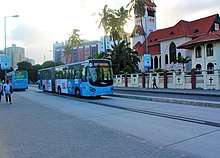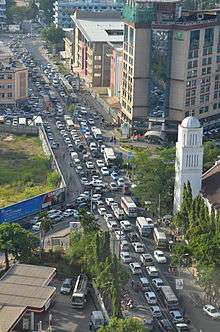Dar es Salaam bus rapid transit
Dar es Salaam bus rapid transit is a bus rapid transit system that began operations on 10 May 2016 in Dar es Salaam, Tanzania.[2] The transit system consists of 6 phases and the construction of the first phase began in April 2012 by the Austrian construction company Strabag International GmbH.[3] Construction of the first phase was completed in December 2015 at a total cost of €134 million funded by the African Development Bank, World Bank and the Government of Tanzania.[4] The first phase of the project has a total length of 21.1 kilometers with dedicated bus lanes on three trunk routes with a total of 29 stations.[5] The entire system is operated by The Usafiri salama Dar es Salaam Rapid Transit (UDA-RT) under the surveillance of the Surface and Marine Transport regulatory authority (Sumatra)[6] Currently, the route is serviced by a fleet of 140 Chinese built Golden Dragon buses, providing express and local service for 18 hours daily from 05:00am to 11:00pm.[7]
 The Usafiri Dar-es-Salaam Rapid Transit Logo. | |
 | |
| Overview | |
|---|---|
| Owner | Government of Tanzania |
| Locale | Dar es Salaam, Tanzania |
| Transit type | Bus rapid transit |
| Number of lines | 1 |
| Number of stations | 29 |
| Daily ridership | 179,000 (August 2017)[1] |
| Website | Company website |
| Operation | |
| Began operation | 10 May 2016 |
| Operator(s) | UDA-RT |
| Number of vehicles | 140 |
| Technical | |
| System length | 21.1 km (13.1 mi) |
| Average speed | 23.0 km/h (14.3 mph) |
History

With the rapidly growing population of the city, the government began to draw plans for a rapid transit system in 2003. The government predicted the city population to grow over 5 million by 2015 and invited the Japan International Cooperation Agency to design a master plan for transport in the city in June 2008.[8] A bus rapid transit and a metro transit system were proposed but the metro system was not approved due to the high construction and operational cost involved. The project was placed under the Prime Minister's office and a Dar Rapid Transit Agency (DART) was created through a government notice on 25 May 2007.[9] A 130 km bus rapid transit was planned to cover over 90% of the city's population and the project was split into six phases due to the large investment required.[10] The initial project cost was financed by the world bank and the bank provided $180 million for the construction of the first phase.[11]
Phases
Phase I
Phase I of the BRT system runs for 21 km from Kimara to Ubungo ending at Kivukoni/Morocco. Construction of the first phase began in April 2012 and was completed in December 2015 by Strabag international GmbH.[12] The route is designed to carry 300,000 commuters daily along 29 stations. The route consists of 21 km of trunk road, 57.9 km of feeder roads, 5 large terminals and 29 stations.[13] The route was placed under interim operations on 24 April 2015 and was fully operational on 10 May 2016, after the fares were decided.[5]
Interim Operations
On 24 April 2015 the Dar Rapid Transit Agency (DART) signed a contract with UDA-RT for the provision of Interim services of the Dar es salaam Rapid Transit system. UDA-RT is a special purpose company formed by UDA and the two Daladala Associations, the Dar es Salaam Commuter Bus Owners Association (DARCOBOA) and UWADAR for the provision of interim services. The interim service was conducted to provide training to future operators and build up local capacity. During interim operations the private dala-dalas were still operational on these routes.[14]
Phase II
Funds for the Second phase were secured in October 2015. The second phase is to run for approximately 19 km from Kilwa to Kawawa south via Kivukoni and is to cost around $160 million. The African Development Bank agreed to fund $141 million for the project, while the remaining funds will come from the government. Construction for the project is due to begin in June 2019 and will take approximately 36 months to complete.[15] Construction of the road will include two flyovers as well. The 20.3km DART project will commence at Gerezani & City Council BRT station. Which will include Kilwa Road, Chang’ombe Road, Kawawa Road, Gerezani Street, Sokoine Drive and Bandari Road.[16] It will be ready by Dec 2020.
Phase III
Funding for the 3rd phase was provided by the International Development Association (IDA). The construction will take place from Gongo La Mboto to City Center, including part of Uhuru Road from Tazara all the way to Kariakoo-Gerezani.[17] construction is set to begin in 2021.
Infrastructure
Stations
There are three types of stations along the route depending on its location and utility:[13]
- Terminals: Terminals are located along the start and end stations for all trunk roads. The Terminals allow transfers between feeder services as well as providing access to various transportation services such as regional buses and private vehicles. Terminals also contain parking lots to allow commuters to leave their cars during the day.
- Trunk Stations: These are the main stations along the trunk routes. They are accessed via pedestrian crossings and the stations are elevated to provide pedestrians safety. There are four types of trunk stations spaced 500 meters apart along the road (A,B,C and D) depending on the passenger demand.
- Feeder Stations: Feeder stations allow passengers to transfer from feeder routes onto trunk stations.
Buses
The BRT system operates a fleet of 140 Golden Dragon buses. There are two types of buses operated along the routes, one which is 18 meters long with a carrying capacity of 150 passengers and the other which is 12 meters long with a carrying capacity of 80 passengers.[2]
Routes and Stations
| DART Phase I | |||||||||||||||||||||||||||||||||||||||||||||||||||||||||||||||||||||||||||||||||||||||||||||||||||||||||||||||||||||||||||||||||||||||||||||||||||||||||||||||||
|---|---|---|---|---|---|---|---|---|---|---|---|---|---|---|---|---|---|---|---|---|---|---|---|---|---|---|---|---|---|---|---|---|---|---|---|---|---|---|---|---|---|---|---|---|---|---|---|---|---|---|---|---|---|---|---|---|---|---|---|---|---|---|---|---|---|---|---|---|---|---|---|---|---|---|---|---|---|---|---|---|---|---|---|---|---|---|---|---|---|---|---|---|---|---|---|---|---|---|---|---|---|---|---|---|---|---|---|---|---|---|---|---|---|---|---|---|---|---|---|---|---|---|---|---|---|---|---|---|---|---|---|---|---|---|---|---|---|---|---|---|---|---|---|---|---|---|---|---|---|---|---|---|---|---|---|---|---|---|---|---|---|
| |||||||||||||||||||||||||||||||||||||||||||||||||||||||||||||||||||||||||||||||||||||||||||||||||||||||||||||||||||||||||||||||||||||||||||||||||||||||||||||||||
There are six planned phases that will serve over 90% of the city's population and currently only Phase I is operational. Phase II is on construction.






Awards
- 2017 : Institute for Transport and Development Policy : Sustainable Transport Award.[18]
- 2018 : Institute for Transport and Development Policy : Sustainable Transit Global Award.[19]
References
- http://wedocs.unep.org/xmlui/bitstream/handle/20.500.11822/25448/1917_2018_te_unenvironment_gef_global_cc_msp_spcc_darcart_bus_rapid_transit.pdf?sequence=1&isAllowed=y
- "Tanzania: Dar Es Salaam Gets New Fast Shuttle Bus Service". allAfrica.com. Retrieved 2016-06-11.
- "Bus Rapid Transit (BRT) Infrastructure Package 1" (PDF). Strabag-international.com. Retrieved 2015-10-19.
- "Dar es Salaam Bus Rapid Transit: Environmental and Social Impact" (PDF). afdb.org. African Development Bank. March 2015. Retrieved 11 June 2016.
- "Tanzania sets the pace for East Africa with rapid bus transit system - Asoko Insight". Asoko Insight. Retrieved 2016-06-11.
- http://www.sumatra.go.tz/
- "Dar sets the pace for East Africa with rapid bus transit system". www.theeastafrican.co.ke. Retrieved 2016-06-11.
- "Dar es Salaam Transport Policy and System Development Master Plan" (PDF). JAPAN INTERNATIONAL COOPERATION AGENCY. June 2008. Retrieved 11 June 2016.
- "Chief Executive Officer's welcoming statement". dart.go.tz. dart. Retrieved 11 June 2016.
- "Section 1: "Why the Bus Rapid Transport"" (PDF). tanzania.go.tz. Government of Tanzania. Retrieved 11 June 2016.
- "Additional Financing for Tanzania's Bus Rapid Transit System to benefit 300,000 Commuters and Create 80,000 Jobs". World Bank. Retrieved 2016-06-11.
- "Bus Rapid Transit (BRT) Infrastructure, Dar Es Salaam, Tanzania". strabag-international.com. Strabag International GmbH. Retrieved 11 June 2016.
- "DART Phase I" (PDF). dart.go.tz. Dar Rapid Transit Agency. October 2015. Retrieved 11 June 2016.
- http://allafrica.com/stories/201505110460.html, Moses (10 May 2015). "Dart Interim Bus Services Set for Take Off". AllAfrica. Tanzania Daily News. Retrieved 21 December 2015.
- "Tanzania: Chinese Firm Wins U.S.$160m Tender for Phase 2 of BRT". All Africa. September 4, 2018.
- "Tanzania to begin phase two construction of Dar Bus Rapid Transit (Dart". The TNews Times. February 12, 2019.
- "government releases Sh5.7 billion for 3rd phase BRT payout". The Citizen. April 13, 2020.
- "Tanzania's Dar wins global award for Bus Rapid Transit system". Daily Nation. July 7, 2017.
- cite web|url=https://www.nation.co.ke/news/africa/Dar-wins-global-award-Bus-Rapid-Transit-system/1066-4004904-22u7vv/index.html%7Ctitle=Tanzania's Dar wins global award for Bus Rapid Transit system|work=Daily Nation|date=July 7, 2017}}
External links
- Official website of DART
- A map of the Phase 1 routes showing connections with other bus routes can be downloaded here.